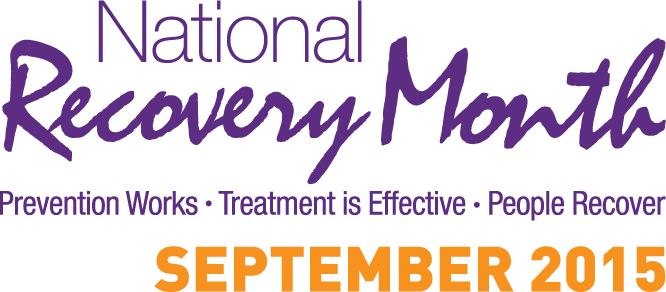Promoting Addiction Awareness and Education
The 25th anniversary of National Recovery Month has compelled communities all over the country to take a more active role in understanding addiction recovery and work toward curbing substance abuse in their locale. Every September our nation learns a little more.
 The 30-day event was first established by the Substance Abuse and Mental Health Services Administration and is meant to promote education regarding drug and alcohol addiction and to help communities promote prevention and offer better treatment to their residents. During its inception, National Recovery Month was known as Treatment Works! Month, and has since evolved considerably to gain more and more grass-roots support as the years have progressed.
The 30-day event was first established by the Substance Abuse and Mental Health Services Administration and is meant to promote education regarding drug and alcohol addiction and to help communities promote prevention and offer better treatment to their residents. During its inception, National Recovery Month was known as Treatment Works! Month, and has since evolved considerably to gain more and more grass-roots support as the years have progressed.
Perhaps the most inspiring part of National Recovery Month is how active it has been in taking away the stigma of chemical dependency and treating it like the disease that it is.[1] In the past 25 years, the addiction recovery field has experienced extraordinary innovation in both its attitude and approach toward its addiction treatment.
Although there is still a great deal of work to be done, National Recovery Month reminds us that the pendulum is swinging toward treatment instead of judgment and penalization.
Addiction Being Seen as Disease Instead of Choice
 Alcohol abuse in America is as old as the nation itself. Many of the earliest settlers were frequent drinkers, and there were even mutual aid societies, or sobriety circles, formed in Native American culture during the mid-18th century.[2] But while alcoholism has always existed, the ways in which our society look at and treat it have changed over time.
Alcohol abuse in America is as old as the nation itself. Many of the earliest settlers were frequent drinkers, and there were even mutual aid societies, or sobriety circles, formed in Native American culture during the mid-18th century.[2] But while alcoholism has always existed, the ways in which our society look at and treat it have changed over time.
For many years, men and women suffering from alcohol dependency were seen as weak-willed, morally flawed and even as criminals. Addiction was considered a choice, not a condition which required treatment. The thought was, if you want to stop, you can just stop. American physician Benjamin Rush (also a signee on the Declaration of Independence) is considered one of the first to suggest that habitual drunkenness should be treated as a disease, rather than a bad habit.[3]
Still, the negative stigma remained with alcoholics, even as the medical field was beginning to discover addiction as a disease. The establishment of the American Society of Addiction Medicine (ASAM) in 1954, followed by the American Medical Association (AMA) declaring alcoholism a treatable condition in 1956 were big steps in shifting the public’s view of alcoholism and addiction.
A Brief History of Addiction Treatment in America
The road from Native American sobriety circles to today’s high standards of addiction treatment was an extremely long and arduous one. It took the work of countless scientists, doctors and other healthcare professionals to The first major addiction problem in America was to opiates, which had become a major health issue by the late 19th century.
begin changing public perception of addiction. Today, more people than ever realize that an addict needs help, not vilification. Initiatives like National Recovery Month continue to raise awareness and educate the public.
Here are some key dates, moments and events in the history of addiction treatment in our nation.
The 1700’s
There was very little known about the effects of prolonged alcohol or drug abuse during the 18th century. American drug use can be traced back to the 1700’s, with the introduction of over the counter medication – most of which contained opium as a main ingredient. These medicines were said to alleviate pain, remedy diarrhea, cure athlete’s foot and even reverse baldness, among many other promises. This market continued to grow well into the 20th century.
In 1784, Dr. Rush published “An Inquiry into the Effects of Ardent Spirits on the Human Mind and Body,” which is widely recognized as a catalyst for the American temperance movement.[4]
The 1800’s
The 19th century marked the first time that medical professionals began calling for some form of rehab for alcoholics. In 1810, Dr. Rush recommended the creation of “sober homes,” to care for alcoholics. In 1830 Dr. Samuel Woodward suggested the creation of “asylums for the inebriated.”
From 1840 – 1845, the first “homes for the inebriate” opened, inspiring the creation of several other alcoholic mutual aid communities around the country. By 1867, the Martha Washington Home in Chicago was established as the first alcohol rehabilitation center in the U.S. specifically for women.
In the 1880s, Sigmund Freud and many American physicians began recommending cocaine as a treatment option for alcoholism and morphine addiction. The century ended with The Keeley League urging lawmakers to sentence alcoholics to medical treatment as opposed to jail time. Additionally, with the shipment of 24,000 pounds of opium to the U.S. from London and the rise of print advertisement, the American public began struggling with addictions to opium based medications, such as morphine.[5]
1900 – 1950
The first major addiction problem in America was to opiates, which had become a major health issue by the late 19th century. A lack of education by the public and medical industry, coupled with the need for immediate pain relief, fueled the rise of the American opiate addiction epidemic, which bled into the 20th century.
Prior to the 1950’s, there was very little addiction rehabilitation available for most Americans. Most treatment at the time was only available to the affluent, in the form of discrete private clinics, mostly serving as a place for them to “dry out” or detox. The closing of morphine maintenance clinics in the mid 20’s basically eliminated any narcotic addiction treatment in the nation.
In 1935, the opening of Shadel Santorium introduced aversive conditioning as a technique for treating alcoholism. During the same year, the U.S. Public Health Prison Hospital opened, marking the government’s first step in joining the movement to treat addiction. Also in the same year, Alcoholics Anonymous was formed.
Over the next 15 years, the tide began shifting even more toward treatment and education. The National Committee for Education on Alcoholism was formed, as was Addicts Anonymous and the National Council on Alcoholism and Drug Dependence.
1950 – 1990
By the early 1950’s, membership in Alcoholics Anonymous had soared to above 90,000. Much of the growth of the organization is credited to depictions of alcoholics in Hollywood, including films like Come Back, Little Sheba and Lost Weekend. In 1952, the AMA became the first organization to define alcoholism.
AMA became the first organization to define alcoholism.
In 1958, Synanon became the first addiction treatment center founded by an addict – this model would be imitated by many all the way through the 1970’s. Insurance companies began reimbursing for alcoholism treatments in the mid 1960’s, and in 1966, President Lyndon B. Johnson appointed the first National Committee on Alcoholism. At the same time, the Narcotic Addict Rehabilitation Act called for an increase in federal funding for addiction treatment.
In 1972, methadone was approved by the FDA for heroin treatment, and multiple acts were passed, urging addiction treatment and allotting funding. Putting a nationally recognizable face to addiction, former first lady Betty Ford received treatment for alcoholism and opioid addiction, following a staged intervention by her family. In 1982, she formed the Betty Ford Clinic (now the Betty Ford Center) in Rancho Mirage, CA, for the treatment of chemical dependency.
The war on drugs of the 1980’s began shifting the focus off of rehabilitation and onto punishment. In 1985, crack cocaine appeared and immediately created a national health crisis, especially in lower income areas. The death of college basketball star and national champion, Len Bias, to a cocaine overdose in 1986 shocked the nation and heightened the public’s awareness about the danger of cocaine.
Modern Day
Some of the stigma of addiction still hovers over alcoholics and drug addicts. Despite a wealth of knowledge about the disease of addiction, there is still more work to be done. New addiction threats have emerged, drug use has not decreased and many alcoholics and drug addicts are still not receiving the treatment they need.
Almost everyone has or will be touched by addiction in some way. National Recovery Month teaches us not to outcast those who struggle with substance abuse, but to try to find ways to help them defeat their addictions. There are several contributing factors to addiction, much of which is not the fault of the addict. A helping hand could be the only thing standing in between an alcoholic or drug addict falling hopelessly into addiction, or turning their life around with treatment.



